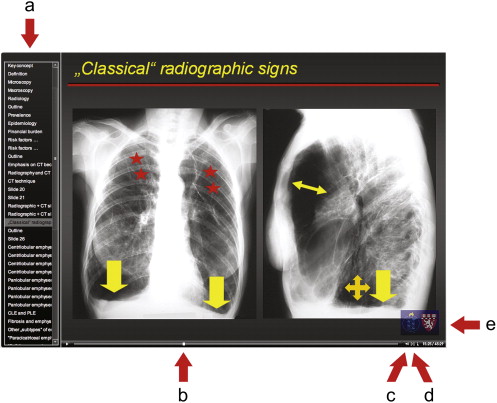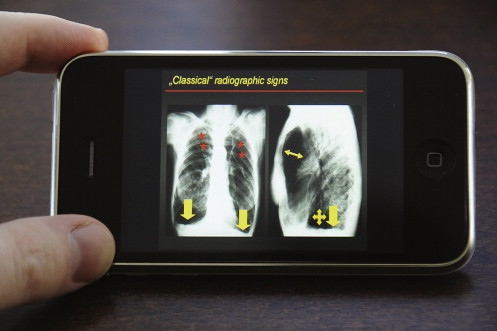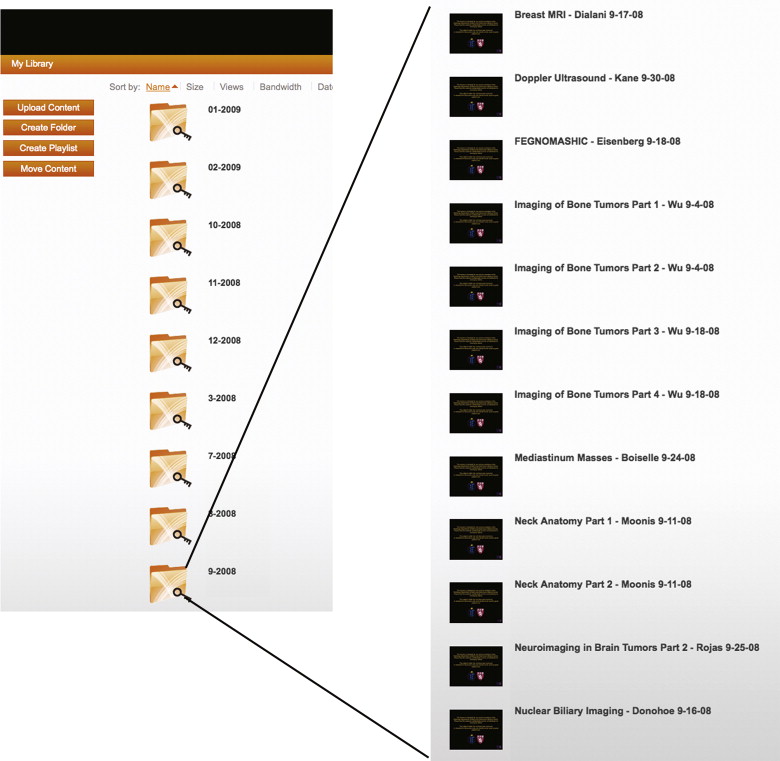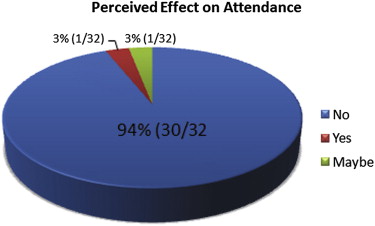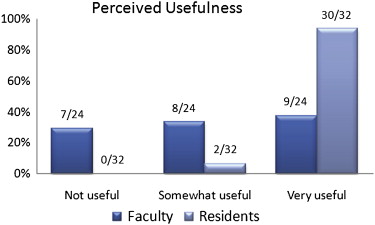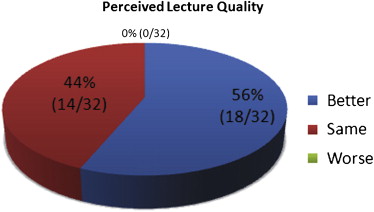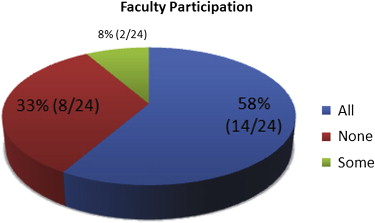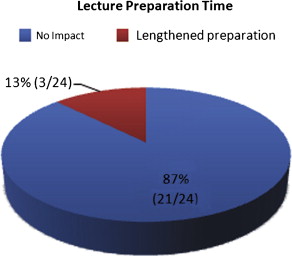Rationale and Objectives
Didactic lectures are an integral component of resident education, but many are missed because of postcall or away rotation status. The authors describe their pilot experience implementing an audiovisual recording program for didactic lectures and report residents’ and faculty members’ perceptions of this experience.
Materials and Methods
From July to October 2008, resident conference didactic lectures were recorded on a voluntary faculty basis and posted to a secure Web site using affordable ($500) commercially available equipment. After the trial period, surveys were administered to residents and faculty members. Questions addressed residents’ use of the system and its perceived usefulness, as well as its impact on conference attendance, lecture quality, and preparation time.
Results
The survey was completed by 32 of 37 residents (86%) and by 24 of 68 (35%) faculty. Median rankings of perceived usefulness of the system (1 = not useful, 5 = extremely useful) were 5 for residents and 3 for faculty members ( P < .01, Wilcoxon’s rank-sum test). The mean numbers of lectures viewed were 1.7 per week during regular rotations and 3.93 per week during away rotations or night float ( P = .02, t test). A majority (21 of 32 [66%]) of residents stated that lecture quality had improved. A majority (21 of 24 [88%]) of faculty members reported no increases in lecture preparation time compared to before the pilot program.
Conclusions
On the basis of its affordability, perceived usefulness by residents, and minimal impact on faculty members’ preparation time, a recording system for didactic lectures has the potential to enhance residents’ learning at only minimal costs to radiology departments.
Didactic conferences are an integral component of radiology residency training, but attendance by all residents can be challenging to achieve . For example, residents may be away because of night float and off-site rotations, vacation, and maternity or paternity leave. Following an assessment of our program’s resident conference attendance, we found that our second-year and third-year residents missed an average of 40% of didactic lectures for these reasons. Thus, for our program and many others, there is a clear need to establish a method that would allow distance learning . Although the synchronous, “real-time” transmission of lectures has been previously reported and is now commonly used, we are unaware of any previous reports describing the routine recording and storage of didactic resident lectures for future lecture viewing.
We therefore aimed to identify and implement a system to provide audiovisual recording of didactic conferences, with the dual goal of ease of use for faculty members recording lectures and residents accessing lectures. Our aims in this paper are twofold: (1) to describe our pilot experience implementing an audiovisual recording program for didactic lectures and (2) to report residents’ and faculty members’ perceptions of the pilot experience.
Materials and methods
Identification of Recording Software and Hardware
Get Radiology Tree app to read full this article<
Get Radiology Tree app to read full this article<
Implementation and Optimization of Software and Hardware
Get Radiology Tree app to read full this article<
Get Radiology Tree app to read full this article<
Software Setup
Get Radiology Tree app to read full this article<
Video Parameters
Get Radiology Tree app to read full this article<
Audio Parameters
Get Radiology Tree app to read full this article<
Microphone
Get Radiology Tree app to read full this article<
Protection of Intellectual Property
Get Radiology Tree app to read full this article<
Recording Trial
Get Radiology Tree app to read full this article<
Survey
Get Radiology Tree app to read full this article<
Get Radiology Tree app to read full this article<
Get Radiology Tree app to read full this article<
Get Radiology Tree app to read full this article<
Results
Performance of the Recording System
Get Radiology Tree app to read full this article<
Get Radiology Tree app to read full this article<
Get Radiology Tree app to read full this article<
Get Radiology Tree app to read full this article<
Get Radiology Tree app to read full this article<
Resident Survey
Response Rate
Get Radiology Tree app to read full this article<
Frequency of Lecture Viewing
Get Radiology Tree app to read full this article<
Get Radiology Tree app to read full this article<
Reasons for Lecture Viewing
Get Radiology Tree app to read full this article<
Get Radiology Tree app to read full this article<
Table 1
Residents’ Reasons for Missing Live Lectures
Reason for Missing Live Lectures Most Common Least Common Rating Average Response Count Prefer to watch lectures on my own time 0.0% (0) 6.9% (2) 20.7% (6)72.4% ( 21) 3.66 29 Postcall40.0% ( 12) 16.7% (5) 16.7% (5) 26.7% (8) 2.30 30 Away on vacation59.4% ( 19) 15.6% (5) 3.1% (1) 21.9% (7) 1.88 32 Away at AFIP or away rotation54.8% ( 17) 9.7% (3) 6.5% (2) 29.0% (9) 2.10 31 Personal/family issues 14.3% (4) 10.7% (3) 28.6% (8)46.4% ( 13) 3.07 28 Other 4.3% (1) 13.0% (3) 13.0% (3)69.6% ( 16) 3.48 23
AFIP, Armed Forces Institute of Pathology.
Reasons were ranked on a scale ranging from to 1 (least common) to 4 (most common). Values in bold indicate the most frequent response to each ranking.
Get Radiology Tree app to read full this article<
Usefulness of Lectures
Get Radiology Tree app to read full this article<
Get Radiology Tree app to read full this article<
Quality of Lectures
Get Radiology Tree app to read full this article<
Get Radiology Tree app to read full this article<
Response to Narrative Questions
Get Radiology Tree app to read full this article<
Get Radiology Tree app to read full this article<
Faculty Participation and Survey Results
Faculty Participation and Response Rate
Get Radiology Tree app to read full this article<
Get Radiology Tree app to read full this article<
Get Radiology Tree app to read full this article<
Perceived Impact on Preparation Time
Get Radiology Tree app to read full this article<
Get Radiology Tree app to read full this article<
Usefulness of Recording Lectures
Get Radiology Tree app to read full this article<
Response to Narrative Questions
Get Radiology Tree app to read full this article<
Comparison Between Faculty Members’ and Resident’s Responses
Get Radiology Tree app to read full this article<
Discussion
Get Radiology Tree app to read full this article<
Get Radiology Tree app to read full this article<
Get Radiology Tree app to read full this article<
Get Radiology Tree app to read full this article<
Get Radiology Tree app to read full this article<
Get Radiology Tree app to read full this article<
Get Radiology Tree app to read full this article<
Get Radiology Tree app to read full this article<
Get Radiology Tree app to read full this article<
Get Radiology Tree app to read full this article<
Get Radiology Tree app to read full this article<
Get Radiology Tree app to read full this article<
Get Radiology Tree app to read full this article<
Get Radiology Tree app to read full this article<
Acknowledgments
Get Radiology Tree app to read full this article<
Appendix A
Resident Survey
Get Radiology Tree app to read full this article<
Get Radiology Tree app to read full this article<
Get Radiology Tree app to read full this article<
Appendix B
Faculty Survey
Get Radiology Tree app to read full this article<
Get Radiology Tree app to read full this article<
Get Radiology Tree app to read full this article<
References
1. Jeun B.S., Javan R., Gay S.B., et. al.: An inexpensive distance learning solution for delivering high-quality live broadcasts. Radiographics 2008; 28: pp. 1251-1258.
2. Martin V.L., Bennett D.S.: Creation of a web-based lecture series for psychiatry clerkship students: initial findings. Acad Psychiatry 2004; 28: pp. 209-214.
3. Solomon D.J., Ferenchick G.S., Laird-Fick H.S., et. al.: A randomized trial comparing digital and live lecture formats. [ISRCTN40455708] BMC Med Educ 2004; 4: pp. 27.
4. Markova T., Roth L.M., Monsur J.: Synchronous distance learning as an effective and feasible method for delivering residency didactics. Fam Med 2005; 37: pp. 570-575.
5. Purcell D.D., Hess C.P., Durack J.C., et. al.: Recording, editing, archiving, and distributing radiology lectures: a streamlined approach. Radiographics 2007; 27: pp. 1839-1844.
6. Jedlicka J.S., Brown S.W., Bunch A.E., et. al.: A comparison of distance education instructional methods in occupational therapy. J Allied Health 2002; 31: pp. 247-251.
